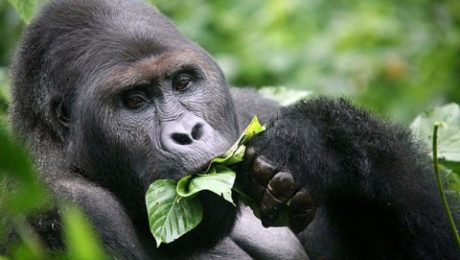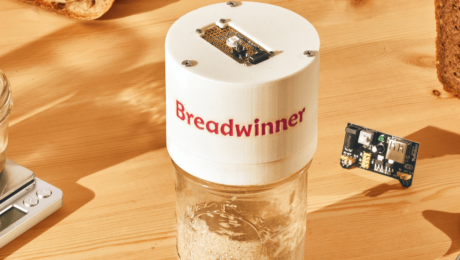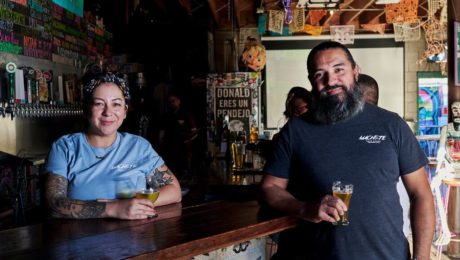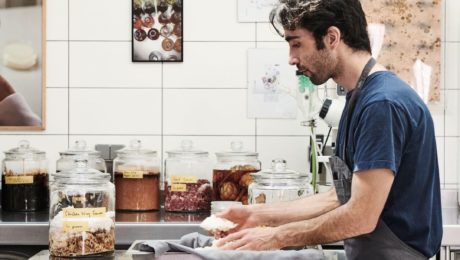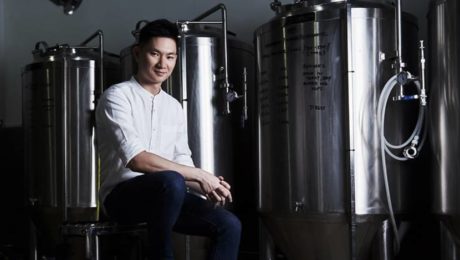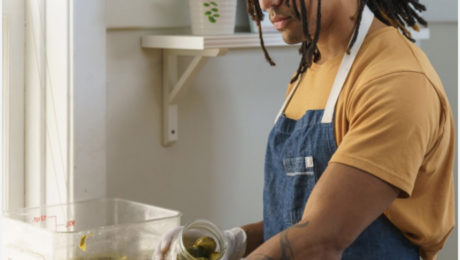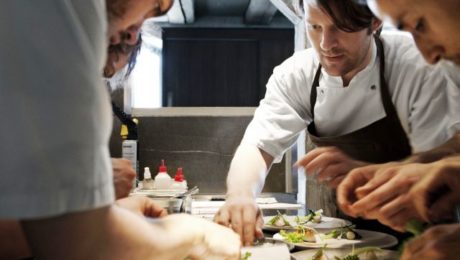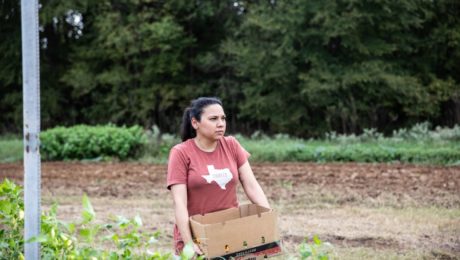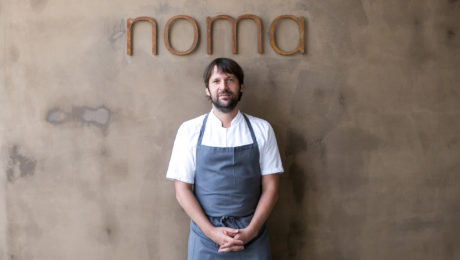Fermentation in Anthropology
Fermented foods have had an impact on human evolution, and they continue to affect social dynamics, according to a new collection of 16 studies in the journal Current Anthropology. This research explores how “microbes are the unseen and often overlooked figures that have profoundly shaped human culture and influenced the course of human history.”
The journal’s special edition, Cultures of Fermentation, features work from multiple disciplines: microbiology, cultural anthropology, archaeology and biological anthropology. Researchers were based all over the globe.
“Humans have a deep and complex relationship with microbes, but until recently this history has remained largely inaccessible and mostly ignored within anthropology,” reads the introduction, Cultures of Fermentation: Living with Microbes. “Fermentation is at the core of food traditions around the world, and the study of fermentation crosscuts the social and natural sciences.”
The impetus for the articles was a 2019 symposium organized by the non-profit Wenner-Gren Foundation. This organization aims to bring together scholars to debate and discuss topics in anthropology.
“Fermentation is at the core of food traditions around the world, and the study of fermentation crosscuts the social and natural sciences,” the introduction continues. The aim of the symposium and corresponding research was to “foster interdisciplinary conversations integral to understanding human-microbial cultures. By bridging the fields of archaeology, cultural anthropology, biological anthropology, microbiology, and ecology, this symposium will cultivate an anthropology of fermentation.”
Here is a listing the included studies:
- Predigestion as an Evolutionary Impetus for Human Use of Fermented Food (Katherine R. Amato,Elizabeth K. Mallott, Paula D’Almeida Maia, and Maria Luisa Savo Sardaro). Using research on nonhuman primates, researchers conclude that “fermentation played a central role in enabling our earliest ancestors to survive in the forested grasslands in Africa where key anatomical features of our species emerged. Fermentation occurs spontaneously in nature. Most nonhuman primates cannot metabolize fermented products, but humans evolved the capacity to use them as fuel. …By breaking down tough and toxic plant species, fermentation helped humans meet the caloric requirements associated with their growing brains and shrinking guts. These anatomical changes both stemmed from and fueled the emergence of collective forms of know-how — microbial and human cultures fed on one another, in this view of the human past.”
- Toward a Global Ecology of Fermented Foods (Robert R. Dunn, John Wilson, Lauren M. Nichols, and Michael C. Gavin). This ecological view of fermentation maps the “emergence and divergence of the world’s many varieties of fermented foods.”
- Prehistoric Fermentation, Delayed-Return Economies, and the Adoption of Pottery Technology (Oliver E. Craig). Craig explores the central role of pottery in “people’s ability to amass the kinds of surpluses that allowed human communities to lay down roots.” Pots were ideal as the storage vessels that made it possible to domesticate microbes.
- Seeking Prehistoric Fermented Food in Japan and Korea (Shinya Shoda). This study focuses on fermentation’s rise in prehistoric Japan and Korea along with each country’s respective cultural achievements.
- Cultured Milk: Fermented Dairy Foods along the Southwest Asian–European Neolithic Trajectory (Eva Rosenstock, Julia Ebert, and Alisa Scheibner). Using archaeological evidence of fermentation, researchers track the “emergence of lactase persistence in sites where dairying made an early appearance. It appears that people ate cheese and yoghurt well before they drank milk: only a small subsection of the human population retains the enzymes needed to digest lactose into adulthood.”
- Missing Microbes and Other Gendered Microbiopolitics in Bovine Fermentation (Megan Tracy). Industrial dairy farms are finding “missing microbes” in cows, Tracy highlights in her study. Newborn calves are separated from their mothers in industrialized dairy farms, and thereby lose the critical gut connections that would have been made by drinking breast milk.
- Living Machines Go Wild: Policing the Imaginative Horizons of Synthetic Biology (Eben Kirksey). Kirksey profiles the International Genetically Engineered Machine competition in Boston, where living creatures made through genetic engineering tools are regarded as machines. “…life is being remade in novel and surprising ways as iGEM students use increasingly fast and cheap genetic engineering tools.”
- From Immunity to Collaboration: Microbes, Waste, and Antitoxic Politics (Amy Zhang). Research details “urban waste activists in China who are practicing a quiet form of resistance to the policies of the authoritarian state by using the fermentation of eco-enzymes to heal sickened rivers, bodies, and soils.”
- The Nectar of Life: Fermentation, Soil Health, and Bionativism in Indian Natural Farming (Daniel Münster). Münster delves into agricultural politics in India. He concludes that “fermentation’s effects are unpredictable: there is always more than one story to tell.”
- Microbial Antagonism in the Trentino Alps: Negotiating Spacetimes and Ownership through the Production of Raw Milk Cheese in Alpine High Mountain Summer Pastures (Roberta Raffaetà). Raffaetà investigates cheesemaking in the Italian alps, contrasting three different approaches — farmers who don’t use contemporary cheesemaking methods and only use microbes found in their terroir, , industrialized cheese producers,; and high-mountain farmers who mix cheesemaking elements from different times, such as using a standardized starter with local cultures.
- Protecting Perishable Values: Timescapes of Moving Fermented Foods across Oceans and International Borders (Heather Paxson). Raw milk cheese, cured meats and assorted ferments get their flavor from microbes. Paxson documents how transportation and distribution can erode the microbial content of these products, especially international imports. She concludes supply chains (especially international) should be further explored to make transporting products with live microbes viable.
- Enduring Cycles: Documenting Dairying in Mongolia and the Alps (Björn Reichhardt, Zoljargal Enkh-Amgalan,Christina Warinner, and Matthäus Rest). This research details the Dairy Cultures Ethnographic Database, an open resource featuring photos and videos of dairy production, landscapes and livestock in the Alps. Interviews, oral histories and folk songs are also included.
- Preserving the Microbial Commons: Intersections of Ancient DNA, Cheese Making, and Bioprospecting (Matthäus Rest). Rest traces the history and spread of dairying in Mongolia, Europe and the Near East. She concludes by calling on scientists and local producers to protect the “microbial commons” from “patenting and commodification.”
- Taste-Shaping-Natures: Making Novel Miso with Charismatic Microbes and New Nordic Fermenters in Copenhagen (Joshua Evans and Jamie Lorimer). This research for this paper took place at Noma in Copenhagen, and studied how fermentation allows the restaurant to tread a fine line “between ecologically responsible localism and the nativism associated with the rise of Denmark’s anti-immigrant right. Noma’s chefs have hit upon kōji, Japan’s “national fungus,” which they turn loose on Danish ingredients.”
- Bamboo Shoot in Our Blood: Fermenting Flavors and Identities in Northeast India (Dolly Kikon). Kikon explores fermented bamboo, a delicacy in India, and how it’s part of the local the community.
- Fermentation in Post-antibiotic Worlds: Tuning In to Sourdough Workshops in Finland (Salla Sariola). Sariola describes fermentation “as a politically progressive form of performance art.” She documents activities in China, where fermentation is used to “challenge the modernist regimes of purification that have turned microbes into the enemy. To learn to live better with microbes is to learn to live better with other kinds of difference — those associated with ethnicity, race, national origins, sexual orientation, ability, and age.”
- Published in Science
The Next Frontier in Kitchen Appliances
Is fermentation the next big home kitchen technique? As more restaurants hire directors of fermentation, consumers are inspired to experiment at home.
An article in The Spoon makes a case for the rise of home fermentation equipment, which makes the process “a little less mysterious.”
“Fermenting is still viewed as something of a black art. Part of it is the weird and slightly creepy terminology (mother, anyone?). Mostly, though, it’s also because the act of farming bacteria to create tasty and healthy new foods is a far cry from the usual activity of assembling and cooking our meals in our kitchen.”
The article interviewed two entrepreneurs making their own fermentation devices: Breadwinner (which helps bakers know when their sourdough starter is ready) and Hakko Bako (a fermentation appliance). The creators say their products are making fermentation easy, controlled and approachable. Tommy Cheung of Hakko Bako notes food trends usually start in Michelin restaurants, then trickle down to casual dining and finally end up at the home kitchen. “I definitely think (home fermentation devices) are going to be a huge part of the future.”
Read more (The Spoon)
- Published in Business
Are Beer Bars Dying?
As the number of craft breweries continues to balloon — growing to nearly 9,000 in 2020 — craft beer bars are going extinct. The New York Times explores why: brewers are turning into competitors. Few people want to drink at a bar when they can instead go to a brewery’s own taproom.
Bars helped the craft industry grow, but now what was once “a prime way of bringing people into bars was gradually taken away by the breweries themselves,” says Chris Black of Falling Rock Tap House in downtown Denver. Black was forced to close his bar this summer, as the COVID-19 pandemic caused sales to plummet.
The pandemic accelerated closures for numerous failing bars across America, a big loss for locals who found community at their hometown establishment. But brewery taprooms aren’t the only culprit. The article notes craft beer used to be found only in bars — now it can be purchased in stadiums and supermarkets.
(Pictured: Joann Cornejo and Eddie Trejo, who run Machete Beer House in National City, Calif. It’s a community-focused bar that offers brews from America and Mexico and features pop-up vendors selling birria tacos and paletas.)
Read more (The New York Times)
- Published in Business
Jason White:“It’s Cool to be a Fermenter”
While more chefs and cooking enthusiasts are experimenting with fermentation, they’re skipping the basics and jumping straight to complicated dishes. The foundational steps of cooking are fine-tuned only with time and patience, with hours spent mastering the simple recipes first, according to Jason White, director of the fermentation lab at Noma restaurant.
“It’s just as important for you to make a delicious pickle and a wonderfully balanced kombucha as it is for you to make an incredibly long-aged batch of miso,” White says. “We can never forget that, whenever we start approaching these biological processes and these fermentation processes, that we also take advantage of the beginning stages of learning each individual step along the way. I can’t tell you how important it is for a person who’s emerging into the art of fermentation to stop and pause for a minute and take the opportunity to connect dots. Each microbe that we’re using to ferment things has some kind of mechanism, and an ingredient that we’re going to ferment has a composition that benefits that microbe.”
White spoke at Harvard University’s Science & Cooking Lecture Series, on the topic Fermentation: A Springboard for Modern Gastronomy. He began his director role at Noma last year and has since helped the world-famous restaurant earn its third Michelin star in September.
In his lecture, White stressed observational skills — honed in the early years of learning to ferment — are one of the most important qualities for a fermenter. The best way to “really understand what an ingredient is and what it has to offer a microbe” is through the senses. When you cut into the ingredient, does it feel dry? Does it smell of essential oils? Does it taste overripe?
“Fermentation is one of those weird occurrences in nature where humans intentionally create something only to watch it decompose, and when it decomposes it produces something that’s more valuable to us,” White says. “I am not a chef, I am not a scientist, I am a dreamer and I am a fermenter and my life journey is going to be dedicated to the act of microbial processing.”
From Texas to Denmark, Fermenting with Local Agriculture
A native of Albuquerque, New Mexico, White began a career as a fermentation consultant for restaurants and distilleries in Texas. He worked for two years at Noma before returning to the U.S. in 2019 as head of the food research lab at Audrey restaurant in Nashville.
The early days of his career in gastronomy weren’t spent in beautiful, state-of-the-art kitchens like those at Noma. White’s first experiences as a professional fermenter were spent cooking in a small wooden shed in the Texas heat.
Environment is a critical element to fermenting. Texas is vastly different from the areas that are the globe’s cornerstones of fermentation — Japan, Korea and Taiwan — and which had inspired White. Texas, for example, doesn’t have a huge variety of mushrooms or produce — but it does have chilies and lots of grains.
“I found a lot of joy adapting traditional recipes into something that was based off Texas agriculture,” White says. Much of his fermentation in those days was driven by koji, which grows well on the grains common to Texas.
White learned a key lesson that he incorporates in his cooking: use the local ingredients and agricultural systems available in the area.
“Every single ingredient on earth, you’re going to find something that is valuable to a fermentation process,” White adds. “Even if we can’t consume it as humans, you can use the fermentation process to make it more delicious.”
Respecting the Past, Propelling the Future
Fermentation has been around since the beginning of humanity. When we ferment, White says, we’re recreating the environment and the processes traditionally used where the ferment was first discovered and practiced.
“And, as fermenters, we are also carrying the knowledge of these practices through the generations,” White says. “And where we are with fermentation, it’s kind of like emergent pop cultures. It’s cool to be a fermenter.”
White characterizes his fermentation style as “somewhere between a control freak and a naturalist.” Fermenters have a “huge sense of responsibility” to maintain food safety, carry on traditional processes and teach new fermenters. …We are protectors of knowledge, we are protectors of ingredients and we are protectors of history.”
Whether fermenting at home for personal use or in a production facility for consumers, “We are all still changing the way microbes are evolving and we’re all still participating in the ancient act and it is truly beautiful….if anyone in this room wants to ferment, you are literally the future of fermentation.”
During his presentation, White demonstrated how to ferment persimmons. In Texas, local farmers would bring persimmons to the restaurant where he worked. They were hard and unripe, not flavorful enough to eat raw, so White soaked them in amazake, a fermented rice beverage. During his lecture, White sliced bright orange persimmons for an amazake bath.
“The beauty in this whole entire thing isn’t how complex it is,” White says. “Fermentation doesn’t have to blow your mind, you don’t have to be like ‘Oh my god, it’s completely transformed, it’s something I don’t even recognize and it makes my palate explode with flavor.’ No. Fermentation could also be something that respects an ingredient and leaves it as is. But enhanced fermentation is something that can make something that is not as valuable as it should be more valuable again. You can turn something that would maybe go in the trash…into something very delicious.”
- Published in Food & Flavor
Reviving Singapore’s Fermentation Culture
Singapore’s so-called “Prince of Fermentation” wants his country to develop “its own brand of fermentation culture.” Tan Ding Jie says Singapore’s traditional ferments are often left out of “the gospel of fermentation.”
“Cinchalok, fish sauce, fermented bean curd, fermented bamboo shoots – these are all very interesting ideas. People who are more mature have been quite ready to adapt koji from Japan and red yeast rice from Asia in their Western restaurants – so I think we should also be able to adapt or loan some of their ideas and use them in our cuisine.”
Tan Ding Jie, a researcher for Singapore’s Agency for Science, Technology and Research, is currently pursuing a master’s degree in food science. Jie consults for different Singapore restaurants and bars on how to use ferments in their menus. He created a fish sauce and nata de coco at the Michelin-starred Labyrinth restaurant, and created kombucha-infused cocktails for Gibson, one of Asia’s top bars. He started his own brand, Starter Culture, and teaches fermentation workshops and sells his own kombucha.
In an interview with Channel News Asia, Jie said he thinks there’s “much to be discovered from looking into our Southeast Asian culinary heritage. … I think Singapore is unique because we haven’t been afraid to say, ‘Let’s learn what are the best practices in the world today, and then apply it to our local context.’ If you look at Southeast Asian ferments, it’s also very simple – we took what immigrants brought over and said, ‘All right, that’s the history, let’s make it local.’”
Read more (Channel News Asia)
- Published in Food & Flavor
Q&A: Sebastian Vargo, Vargo Brother Ferments
Sebastian Vargo was an up-and-coming chef on the Chicago food scene when the Covid-19 pandemic hit and shuttered restaurants. Laid off from his job as head chef at Merchant Restaurant, Vargo experimented with different gigs — yoga teacher, realtor, even t-shirt graphic designer — but kept coming back to his passion: creating food.
So Vargo and his fiancée, Taylor Hanna, launched Vargo Brother Ferments. They produce a creative line-up of fermented condiments, sauces and beverages, including items like a pickled garlic sauce, chipotle beet sauerkraut, Mighty Vine tomato vinegar, Concord grape kombucha and a Bulgarian yogurt with fermented strawberry jam and miso peanut butter.
“Ultimately, I’m a flavor chaser,” Vargo says. “Fermentation is not really an obligation, it’s a necessity to really unlock certain flavors.”
Most of what they make is seasonal, created from fresh ingredients sourced locally from Chicago community gardens or out of Vargo’s backyard garden. Flavors heralding back to Vargo’s childhood are also featured. Collard greens kimchi is one example, featuring the leafy vegetable frequently served at Vargo’s family dinner table as he grew up in Detroit.
“You can’t help but find a little bit of nostalgia in what you make. Flavors are so connected to memories,” Vargo says. He recalls his mother’s buttery cornbread, her pinto beans flavored with a smoked ham hock and his grandmother’s braised short ribs with sauerkraut. “We were this African-American family in the Midwest in the ‘90s with Southern heritage, so some of my food preserves some of that history. With fermentation, there’s an intersection of both physical preservation and historical preservation. My fermented vegetables are an homage to the past, presenting certain vegetables in interesting and complex ways.”
Vargo and Hanna currently run their business from their home kitchen, selling over Instagram, at farmers markets and through collaborations with local restaurants around the Chicago area. They’re nearing the end of a Go Fund Me campaign to help move Vargo Brother Ferments into a commercial kitchen and, eventually, a storefront. .
Below is an edited Q&A between Vargo and The Fermentation Association.
The Fermentation Association: How did you first get into cooking?
Sebastian Vargo: My origin is with my grandmother. My mom worked really hard, she worked nights and then she was going to school as well. My grandmother was in our household a lot, she taught me and my brothers [the namesake behind Vargo Brother Ferments] a lot of life skills, how to box, how to play basketball, how to cook. I have fond memories of eating sauerkraut as a child out of a coffee mug with a fork. She was my earliest inspiration, I have fond memories of my grandma in the kitchen.
TFA: And how did you get into fermentation?
SV: My grandma introduced me to sauerkraut. It was such an exciting flavor, I hadn’t experienced the brininess of lactic fermentation, the way it feels on my tongue and cheeks. My mom loved to take us to local delis and we loved Reuben sandwiches. We’d go to a lot of Jewish delis in southeast Michigan, and they had salt brine pickles. That was a real fermented pickle, that flavor is something, too, that really kind of jump started my interest in fermentation.
And then, just working with cool chefs. A new part of my mind was unlocked at every restaurant. Great chefs helped cultivate my love of fermentation. Being in the industry in Chicago is so cool. Every last one of us, we’re all trying to experiment and see what we can do with flavors. When I worked for Stephanie Izard at Girl & the Goat, we were doing kimchi for certain dishes. At Schwa with Brian Fisher and later Wilson Bauer, we made our own yogurt and fermented our leeks, our apricots. And then when I worked for Tony Quartaro at Dixie, he was really pushing the envelope with this Southern-style restaurant where we took inspiration from around the world in a way and applied it to this Southern technique. We had some peaches come in that were underripe, we couldn’t use them for the actual dish, so instead he mixed it with some rum and taught me how to make a vinegar out of it.
TFA: What took you from Detroit to cheffing in Chicago?
SV: It was one Le Cordon Bleu commercial. I was young, I was in a bit of a crossroads and I made the decision to go to the Le Cordon Bleu culinary school in Chicago. I was working at the Salvation Army at the time and I got on the Megabus with my little thrift bags and maybe $800. I had no plans, I found out $800 will not get you an apartment in Chicago, so I stayed in hostels. Before I got enough money for culinary school, I worked as a canvasser to make money.
TFA: March 2020. You are the head chef at Logan Square’s Merchant and your fiancée was cooking at the Ace Hotel. Then Covid-19 lockdowns happen. Tell me how your lives changed.
SV: Merchant was the first restaurant where I was head chef, it was fun. We made our own hot sauces, we fermented pickles. But once I had the call that we were closing for Covid, I was ready to figure something out. I was a little bit burnt out from the industry at the time. I was ready to leave, it’d been a lot of pressure and a lot of stress for a while. So, like a lot of Americans, we took the unemployment. I had never been on unemployment. Being unemployed gave me a chance to finally reset. I was working up to 120 hours a week cheffing around. Now I could see what else is out there.
The whole time I was looking outside of the industry, me and Taylor were still doing a lot of experiments in the kitchen. We were making a lot of bagels, making pickles. I have a friend Joe Morski who runs a one-man sandwich operation called Have a Good Sandwich. It’s like a rotating sandwich club in Chicago. Meanwhile, I was trying to start a pickle club, and I asked him if he wanted to serve my pickles in the lunch pack for his sandwiches. That was my first foray into getting my pickles out there. From there, we just started peddling our jars.
TFA: What was the transition to your own business?
SV: To this day, there’s so few fermented, unpasteurized pickles on the market. It wasn’t even a search for a niche, it was something I love to do and I was excited to share my flavor palette with the public. Fermentation is a fun way to be creative, to use it as a platform for new dishes, to play aground with colors. It’s definitely been a great medium to pursue my love of food, of art. Feeding people is my love language. And fermentation is definitely something that’s going to live on forever. It’s wellness, it’s never going to go out of style.
TFA: Tell me about your G-Dilla pickle. That’s a customer favorite. What makes it so special?
SV: The G-Dilla pickle is a flagship that’s always in season. The name G-Dilla, we have blank labels and I didn’t want to write “Garlic Dill” each time. So I started G-Dilla as an homage to J-Dilla, a great producer [and rapper from Detroit].
The taste is akin to a Jewish deli, a garlic dill pickle, the one that would accompany a Reuben sandwich. I just take it kind of a step further with the herbs and the garlic. We use black tea in our pickle brine, it is a fun way to add tannins to the mix which provides that nice, crunchy skin. We really enforce the flavors through fresh herbs, fresh dill from our backyard, parsley, grape leaves, fresh bay leaf and we add lots of garlic and toasted block peppercorn and mustard seed. Maybe a little gochujang, some turmeric. You bite into one and you’re getting that loud crunch and you’re just getting that lactic acid zing that’s electrifying the flavor. It makes you stop what you’re doing, you can’t talk through it, you have to finish chewing and enjoy the whole experience. It’s been a journey — I think back to the first pickle I made to now and it’s something I’ve kept at, I’m a student of the game, always striving to learn more techniques and refine what I’m doing.
TFA: Why do you think more and more chefs are exploring fermentation?
SV: I think so many chefs are seeing the flavor benefits alone. Food fermentation offers a more nuanced flavor that you just can’t achieve the same way. Fermentation is in everything that we do, everything that we eat. There is really an endless source of inspiration and flavor for chefs. We’ve seen the interest pick up in fermentation, but it’s not a fad in the food world. Fermentation is something that is here to stay, with the recent explosion and interest in it, fermentation will find a nice settling place in food.
TFA: What do you think is the future of fermentation?
SV: I would like to see a future in which fermentation is no longer just a trending topic, something that everyone acknowledges for its real health benefits. So people aren’t just taking a probiotic gummy, they know they can get probiotics easily through so many foods. Society is at a place where we are not quite as healthy as we should be. Maybe we can make fermentation convenient, maybe we can show people that it’s not hard, we can show folks that there’s food you can have that has enhanced flavors and there’s something in fermentation for everyone.
- Published in Business, Food & Flavor
Noma Finally Earns 3rd Michelin Star
Fourteen years after earning two stars from the Michelin Guide, Noma was finally awarded the illustrious third star.
“After so many years of working together, to finally achieve something like this is extremely special,” says René Redzepi, chef and co-owner of the Copenhagen-based restaurant, during Michelin’s ceremony for Nordic countries earlier this month. Redzepi said the announcement left him surprised and flabbergasted. “I’m completely blown away, it’s a new feeling for me. This opportunity happens once in your lifetime.”
Long lauded as one of the top restaurants in the world, Noma has an innovative fermentation lab and test kitchen that creates wildly imaginative and ingenious dishes. Their summer menu featured an edible candle made with cardamom, saffron and a wick of silvered walnut; a salad made with reindeer penis; and a cold-pressed beetroot juice served in a flower pot adorned with a ladybug made from raspberry and black garlic .
The reactions from food industry professionals echoed the same sentiment — the third star was overdue.
James Spreadsbury, restaurant manager at Noma, said during the ceremony that the staff at the restaurant has been patient. “At some point, we kept on and didn’t expect anything would change. But we were still so proud of what we did and believed in what we did. After so many years of working together, to finally achieve something like this is extremely special.”
Redzepi was also honored by Michelin. The Chef Mentor award, given annually to a chef sharing their knowledge to help others, was presented to him by Peyman Sabet, the vice president of business development for Michelin.
“It’s really about innovation and making the path for a new generation of chefs,” Sabet said.
Redzepi said he was humbled to receive the award. He noted that, when Noma opened 18 years ago, “I was a terrible leader…when you are in the industry, you find yourself becoming a head chef and you don’t have the tools to actually figure out how are you doing to do this, how are you doing to lead and inspire a team.”
He said years ago he “promised himself this is not who I wanted to be.”
“One of the most enjoyable things I have in my professional career is to see someone that’s been a part of your own success, but when they leave they have their own success. That’s really really enjoyable.”
Noma is proud of their alumni and highlights them on their website. Reads the webpage: “Our chef René was himself a stagiaire [a cook who works briefly, for free, in another chef’s kitchen] around the world before opening Noma. It is a part of sharing ideas and knowledge that is quite special in our trade. We wouldn’t want to be without stagiaires and we believe that everyone that has been through Noma shares in part of our success.”
Former Noma chefs include: David Zilber (nowat bioscience company Chr. Hansen), Thomas Frebel (head chef at INUA in Tokyo), Dan Giusti (founder of chef training company Brigaid), Matt Orlando (head chef at Amass Restaurant in Copenhagen), Søren Ledet (owner and restaurant manager at Geranium in Copenhagen) andMads Refslund (head chef of ACME in New York City)
- Published in Business, Food & Flavor
Q&A with Jessica Alonzo of Native Ferments TX & Petra and the Beast
Cheffing is a second career for Jessica Alonzo. Originally a hospital administrator in Dallas, she liked the stability and the benefits, but wasn’t happy. She longed for the days around the kitchen table with her mom, cooking for large family gatherings — “I have such fond memories of food.” Hospital pay got her through culinary school, and then she joined the acclaimed Dallas restaurant FT33 as a line cook. It was there that she got introduced to fermentation.
“With fermentation, the transformation of ingredients is just insane,” Alonzo says. “Fermentation is not new, it’s something that we’ve been doing for thousands of years. It’s a lost art and now it’s starting to make a resurgence.”
Fermentation and whole food utilization are Alonzo’s specialty. Whole food utilization, the cooking technique of using the entire animal or produce, marries perfectly with fermentation. Instead of discarding food scraps, skilled chefs are using the byproducts in brines, condiments and sauces.
“I preserve with a purpose,” says Alonzo, a Texas native. “I’ve worked with farmers long enough to understand what works with their produce throughout the year and what doesn’t. I’ve harvested with them, I’ve worked on their land. It plays a big role in fermentation to know how to properly preserve what farmers are harvesting.”
Alonzo is the sous chef at Dallas-based Petra and the Beast, a James Beard Award semifinalist known for its seasonal tasting menu. She stepped back to part-time status this year and launched her own business, Native Ferments TX, a larder shop that sells local ferments and offers virtual fermentation classes. Below are highlights from TFA’s interview with Alonzo.
The Fermentation Association: Tell me where the idea for Native Ferments came from.
Jessica Alonzo: Misti (Norris, chef/owner at Petra and the Beast) and my husband really pushed me to do it. They were like “You have the drive, you have the knowledge — why not share that talent with others?” People are always messaging me on Instagram asking me about different fermentation methods, and now I can teach them through classes. I love fermentation, I’m just fascinated with it, and it’s just continuous learning for me. You feel like you never really learn everything with fermentation, there’s so many different types of cuisines and techniques.
TFA: Why is it so important to you to support local farmers through fermentation?
JA: With both Native Ferments and Petra and the Beast, I get to work with farmers and support them, which is really what I love doing. Noma is helping make fermentation popular again, opening people’s eyes to the fact that fermentation has been happening forever. Fermentation is not new, there’s a tradition to respect. It was done back in the day because of necessity, people had to figure out how to save their harvest, and fermentation made it so they’d have the nutrients from their harvest throughout the rest of the year.
During the pandemic, restaurant sales for farmers dropped off drastically. At Petra, we had one of our farmers come to us with like a hundred pounds of mushrooms they couldn’t sell and they were going to go bad. I preserved them and made mushroom conservas and dried and did all these things with it, and then we ended up selling some of the mushroom pickles and conservas. I don’t know if any other restaurant did that in Dallas. It forced us to be really creative with food.
On my website for Native Ferments, I have profiles of the main farmers I use. When I sell at farmers markets, I have a big board with their Instagram handles. It’s their livelihood, I don’t want any of their produce to go to waste or to compost, I want the community to enjoy it. The magic of fermentation is transforming these simple ingredients with the natural microbes around you. I’ve worked with many of these farmers long enough to know what type of technique works well to pickle or ferment. I want to help educate people and get them excited and spread the word about the farmers’ hard work.
TFA: Tell me more about whole food utilization.
JA: At Petra, Misti was more the meat charcuterie person. She knows how to utilize every part of a pig or an animal. My mind goes more to vegetables, which I think is why we make such a good team. It makes sense that whole food utilization and fermentation go hand-in-hand. It’s part of preserving. We may be prepping something for tasting and then we have like carrot scraps or like some sort of vegetable or fruit scraps and we’ll automatically turn that into a vinegar. Or we dehydrate our char and dehydrate skins and turn that into part of a seasoning for another dish. Or I’ve done like roots from spring onions, I’ll brine those or I’ve chopped them up and parts in a condiment. We try to be as low waste of a kitchen as possible.
I do that with my ferments here with Native Ferments, too. In my fennel kimchi, I use the entire part of the fennel in that fennel kimchi, the fronds, the stems, everything, and then if my ratios were a little different so I did have some fronds left over, I dehydrate those and make that into a powder and now i’m utilizing that powder into a cure that I’m using on carrots for vegetable charcuterie. Understanding flavor profiles, too, helps when you’re cross utilizing your larder.
TFA: So tell me what have been some of your favorite fermentation creations you’ve been working on lately.
JA: Vegetable charcuterie is pretty cool, I’ve gotten some local produce in different root vegetables and I’m working on different charcuteries with more whole utilization in the curing. So like using the fennel from powder for part of the cure with carrots. I’m doing some shiro shoyu for another chef here in town and gluten-free shoyu for myself. I just smoked some beets and I’m pickling them in a shio koji that I made with a half sour brine and some spring onions. I’m hoping it takes on a meaty, smoky-like brisket, I was really craving barbecue when I did it.
TFA: Why do you think fermentation has become such a bigger interest among chefs?
JA: I think chefs are understanding the importance of the different complexity that you get when you build with fermented food in your cuisine. When Misti and I create dishes at Petra, we always in every dish that we create have some sort of pickle or ferment. Whether it’s an actual fermented vegetable or it could be an amino sauce that I’ve made or a shoyu or using shio koji or something, you don’t get that same transformation just by sauteing vegetables. You see the transformation by marianating them in shio koji first or using a brine in your pasta sauce rather than using a lemon juice. That’s how you build on these complex flavors. Some chefs are really trying to understand that. Utilizing fermented foods in their cuisine, being more creative with their flavor profiles, that’s what we do.
TFA: What do you think is the future of fermentation?
JA: With the resurgence of fermentation, I think it’s going to be more accepted in every household. I would hope that it would be something that every household would have. My parents grew up in the ‘60s, when everything was in a can. We had our traditional Mexican food, but we also had those times where it was Americanized, like everything in a canned food. Fermentation, this really should be the norm. Consumers need to be more aware of how beneficial it is
- Published in Food & Flavor
Managing Fermented Food Microbes to Control Quality
Fermented foods are produced through controlled microbial growth — but how do industry professionals manage those complex microorganisms? Three panelists, each with experience in a different field and at a different scale — restaurant chef, artisanal cheesemaker and commercial food producer — shared their insights during a TFA webinar, Managing Fermented Food Microbes to Control Quality.
“Producers of fermented foods rely on microbial communities or what we often call microbiomes, these collections of bacteria yeasts and sometimes even molds to make these delicious products that we all enjoy,” says Ben Wolfe, PhD, associate professor at Tufts University, who moderator the webinar along with Maria Marco, PhD, professor at University of California, Davis (both are TFA Advisory Board members).
Wolfe continued: “Fermenters use these microbial communities every day right, they’re working with them in crocks of kimchi and sauerkraut, they’re working with them in a vat of milk as it’s gone from milk to cheese, but yet most of these microbial communities are invisible. We’re relying on these communities that we rarely can actually see or know in great detail, and so it’s this really interesting challenge of how do you manage these invisible microbial communities to consistently make delicious fermented foods.”
Three panelists joined Wolfe and Marco: Cortney Burns (chef, author and current consultant at Blue Hill at Stone Barns in New York, a farmstead restaurant), Mateo Kehler (founder and cheesemaker at Jasper Hill in Vermont, a dairy farm and creamery) and Olivia Slaugh (quality assurance manager at wildbrine | wildcreamery in California, producers of fermented vegetables and plant-based dairy).
Fermentation mishaps are not the same for producers because “each kitchen is different, each processing facility, each packaging facility, you really have to tune in to what is happening and understand the nuance within a site,” Marco notes. “Informed trial and error” is important.
The three agreed that part of the joy of working in the culinary world is creating, and mistakes are part of that process.
“We have learned a lot over the years and never by doing anything right, we’ve learned everything we know by making mistakes,” says Kehler.
One season at Jasper Hill, aspergillus molds colonized on the rinds of hard cheeses, spoiling them. The cheesemakers discovered that there had been a problem early on as the rind developed. They corrected this issue by washing the cheese more aggressively and putting it immediately into the cellar.
“For the record, I’ve had so many things go wrong,” Burns says. A koji that failed because a heating sensor moved, ferments that turned soft because the air conditioning shut off or a water kefir that became too thick when the ferment time was off. “[Microbes are] alive, so it’s a constant conversation, it’s a relationship really that we’re having with each and every one on a different level, and some of these relationships fall to the wayside or we forget about them or they don’t get the attention they need.”
Burns continues: “All these little safeguards need to be put in place in order for us to have continual success with what we’re doing, but we always learn from it. We move the sensor, we drop the temperature, we leave things for a little bit longer. That’s how we end up manipulating them, it’s just creating an environment that we know they’re going to thrive in.”
Slaugh distinguishes between what she calls “intended microbiology” — the microbes that will benefit the food you’re creating — and “unintended microbiology” — packaging defects, spoilage organisms or a contamination event.
Slaugh says one of the benefits of working with ferments at a large scale at wildbrine is the cost of routine microbiological analysis is lower. But a mistake is stressful. She recounted a time when thousands of pounds of food needed to be thrown out because of a contaminant in packaging from an ice supplier.
“Despite the fact that the manufacturer was sending us a food-grade or in some cases a medical-grade ingredient, the container does not have the same level of sanitation, so you can’t really take these things for granted,” Slaugh says.
Her recommendations include supplier oversight, a quality assurance person that can track defects and sample the product throughout fermentation and a detailed process flow diagram. That document, Slaugh advises, should go far beyond what producers use to comply with government food regulations. It should include minutiae like what scissors are used to cut open ingredient bags and the process for employees to change their gloves.
“I think this is just an incredible time to be in fermented foods,” Kehler adds. “There’s this moment now where you have the arrival of technology. The way I described being a cheesemaker when I started making cheese almost 20 years ago was it was like being a god, except you’re blind and dumb. You’re unleashing these universes of life and then wiping them out and you couldn’t see them, you could see the impacts of your actions, but you may or may not have control. What’s happened since we started making cheese is now the technology has enabled us to actually see what’s happening. I think it’s this groundbreaking moment, we have the acceleration of knowledge. We’re living in this moment where we can start to understand the things that previously could only be intuited.”
- Published in Food & Flavor, Science
Redzepi: We Need Restaurants to “Feel Alive”
Restaurants have been under tremendous economic pressure, suffering from business losses during the Covid-19 pandemic. And there’s now a staffing shortage, as long hours and low pay have driven many away from the industry.
Bloomberg columnist Bobby Ghosh explored how restaurant dining may change in an Instagram live interview with Rene Redzepi, owner and co-owner of Noma, Copenhagen’s two-Michelin star restaurant world-renowned for its experimental fermentation lab. Pandemic restrictions shut down Noma twice, forcing Redzepi to create additional revenue streams outside the traditional dining room.
In the summer of 2020, Noma opened an outdoor, walk-in burger and wine bar. Earlier this month, they announced Noma Projects, a direct-to-consumer line that will initially sell garums.
Below are highlights from Ghosh’s interview with Redzepi.
Ghosh: What did you learn about how people were feeling about returning to restaurants?
Redzepi: Restaurants, you don’t need them to stay alive but you need them to feel alive. That was very, very clear, that people were ready to go out. You know they say it’s the catch-up effect, and that definitely happened here in Copenhagen. People were everywhere, they were in piles to get a bite to sit down, have a glass of wine and meet other people.
Ghosh: When you began to think about reopening the proper dining space and planning your menu for the reopening, did you have any particular thoughts or concerns about whether people’s habits in restaurant dining might have changed in the course of the year that they were all locked up?
Redzepi: Yeah, so we went through the first lockdown, opened up, we were open for about five months and then it all came back and we had to close (again during the second lockdown). On the second lockdown, we were shut for six months and, in that time, we were very worried about everything, I mean we still are, but I guess we’re a little less worried now than before because we’re finally open again. We did think “Would people even sit for hours in a restaurant? What is it that everyone wants?” Besides that, people in Denmark, they started really cooking at home again. Takeaway offerings had become quite common, even from some of the best restaurants, something that would be considered completely impossible five years ago. If you had takeaway as a fine dining establishment, you sort of sold out in a way and that was starting to happen.
But I decided with myself, and that was a personal decision, is that in my life I need this creativity, I need to have guests, I need to work on a menu on a daily basis, so during the lockdown I went to work every day in the kitchen as if we were going to open the following day. We actually made two full menus and one of them will never be served because we ended up being closed throughout it. And then we said “OK, let’s just open up and see what happens, will people still want to come out?” and we opened up our reservations knowing that we would cater only to 100% local crowd and it’s gone really well, really really well.
Ghosh: The thrill of being in a nice restaurant and being able to talk to people and enjoy a meal is incomparable um and I do appreciate the value of fun after the year and a half that we’ve all had. Can you give us an example of a dish that you have in your menu now that reflects this attitude of fun, the surprise.
Redzepi: Swedish saffron believe it or not, it’s really, really strong and tastes amazing. We make this fudge with it and we found out that you can actually use the sort of the cutting of walnut as a wig for candles because the oil content in the walnut makes it flammable. And so we basically shaped or molded this little toffee into a candle. It sounds complicated but it’s quite easy to do when it’s hot and then we put this walnut light into it and it comes to the table when they’re drinking coffee and people think it’s you know for coziness and then as it burns out people are then instructed to eat it that’s a that’s a moment where that’s fun you know it’s creativity, it’s delicious it surprises people and it just really makes it makes a difference to people you can feel that they’ve been needing something like that.
Ghosh: What have you learned that you didn’t already know about restaurant economics over the past year that now factors in your thinking about what Noma is and what Noma needs to be in the future.
Redzepi: Oh man, you’re hitting something that we’ve been talking about for the past two years because, particularly in the last year-and-a-half, restaurant economics, they’re terrible. We’ve had 18 years of operation and we’ve had an average profit of 3%. It’s just enough to keep us running and keep painting the house, so during this pandemic we did think to ourselves “Are we going to continue like this for another 18 years, where we don’t have any money to change anything, even if we want it?” You know we’re going to have to find different ways of operating so that we can have a different economics in it. We have to figure out a way if we want to be here for another 18 years because you know it won’t continue like this. So we have definitely thought of many many things and recently we launched this thing that we call Noma Projects. Noma Projects is a sort of a platform to launch a myriad of things, it’s a for-profit company, but we only want to attack projects that also connect to some sort of a worldly issue, and the first project one is is a vegan and a vegetarian garum sauce that you use as a flavoring to add umami to your vegetarian and vegan cooking. It’s a way to help people eat more vegetarian so that’s project one, that’s something that we worked on almost almost since the first lockdown that happened to us we were like we need to step into this.
Ghosh: About six months ago, I did a piece about restaurant economics and the pandemic. I talked to your friend David Chang of Momofuku. We’re saying that we have to figure out more ways to find revenues outside of the dining room. You know, can we get 50% of the revenue from outside of the dining room where the margins are larger to sustain, to underwrite the amazing creativity that goes on in your kitchens? Is that possible? Have consumer tastes or consumer behaviors now changed in a way that will allow that kind of thing?
Redzepi: I think what happened during the pandemic is that it’s been considered more OK for restaurants of say Momofuku caliber or Noma to actually think of ways to put better economics into the system. That has opened a new door and for us, we’re grabbing that opportunity, we need to, definitely. Our industry needs to, in general. It’s an industry that’s under copious amounts of pressure, we deal with poor profit margins, low incomes, people are overworked, they’re underpaid, there’s bad management and a lot of it is a result of there’s simply no money in the industry, people can’t afford to do maneuver any new way they want, and we don’t have any business training either. It’s very interesting what’s going on. I think a lot of creativity is going to come out of restaurants in the next couple of years.
Ghosh: Now in addition to being a chef, you’re a thinker in your line of work. Through MAD Academy, which used to be anyway your annual gathering of of great chefs from around the world, you’ve spent a lot of time thinking about your industry and the future of your industry. I imagine that during the course of the past year, year-and-a-half you’ve had many conversations with the kinds of people who would previously have come to that conference. What are some of the common themes, the common challenges for fine dining establishments?
Redzepi: I think in food in general, the most common problem, and I think it’s going to continue for a while, is that there’s a gigantic staff shortage right now. I think in the pandemic, a lot of people have had an opportunity to rethink their life and say “OK, am I in this industry for the next 20 years or is this a moment for me now to start studying or become a farmer or something else.” That is really the biggest issue that we have right now, there’s no question in my mind. This is something that at MAD we’ve been discussing for almost a decade. If we’re not able to help transform (and this includes myself by the way I’ve spoken about this many times) this gigantic lack of leadership that we face as an industry where we have a poor ability to actually just manage ourselves, manage our restaurants and be supportive of people, that will be the first step that needs to happen which is slowly happening. But then providing better pay and better work hours, that are related to economics. I see our industry being far from that, unless we figure out a way to either charge more that there’s more value towards foods and people that work in the industry or we find other revenue streams. Those are the big, big questions that we are dealing with at MAD. At Noma, I deal with this as a employer myself, how to actually be an inspiration, but how to also provide for staff that are having children, and how can we have everyone stay here for 40 years in this industry? That’s really hard questions.
- Published in Business

